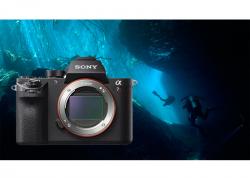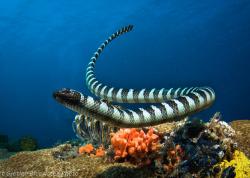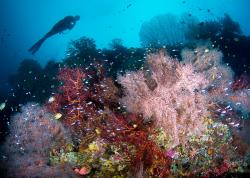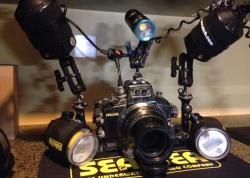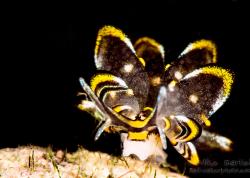The Art of Blackwater Photography
The idea of back rolling into the open ocean at night, may not be a fun idea for the uninitiated. In fact, open ocean diving at any time of the day sends chills up a diver's spine. The 360-degree environment can be intimidating to say the least, but once a diver’s skills have been mastered, exploring the open ocean is limitless.
Blackwater diving is reaching a fever pitch with underwater photographers worldwide. What started out as just a few who dared to venture into the open ocean at night, is rapidly becoming the next big thing for underwater photography.
In this short article, I will try to introduce some of the key dive skills needed for blackwater diving as well as photo tips for capturing blackwater images - how to find the subjects, how to approach them, and the special gear needed to do it.
Blackwater Diving vs Bonfire Diving
So as not to confuse the terms and to establish a clear difference, there is “Blackwater diving” and “Bonfire diving”.
Blackwater diving is done in the open ocean; it is NOT an ordinary night dive with a subject photographed in the dark. Blackwater diving is done where there is no bottom, over very deep water, using a downline and lights to attract larval and pelagic subjects.
Bonfire diving is done over a shallow area by using torches planted in the sand or hanging them in the water (or both) facing deeper water. During a Bonfire dive, one can expect to see subjects that are still larval but closer to the settling stages of their lifecycle. Bonfire style dives are also a great way to learn the dive skills, hunting skills and photo skills needed for blackwater diving but without the stress.
Both styles of diving are equally important to gain a better understanding of the marine world. Both will expose divers to a variety of jellyfish, salp, comb jellies, pterapods. shrimps, octopus, squids, the list is endless…
Technique and Tips
Dive technique is critical to capturing better images, and never more importantly then when black water diving. Limiting your hand movements and fin kicks are essential as personal pressure waves cause your target subjects to close up, spin away, or worse, disintegrate. Using a strong hand-held torch with a tight beam, search the dark water for reflective subjects or anything that might catch your eye. Once found, use the subject’s momentum to drift along with it, and photograph it to the best of your ability. Mastery over dive skills really plays an important role in this environment, and it will take a few dives to get it dialed in.
Camera Settings
When shooting blackwater subjects, I suggest the following settings:
• Higher ISO – (360-600 for DSLR)
• Higher F-stops – (f/18-f/25)
• Shutter speed – 1/200 sec
I prefer higher ISO so that I can push my f-stop higher while using a lower strobe power. This allows my strobes to recycle faster for repeat exposures. If the subject is shiny, quickly increase your f-stop to reduce over-exposures. If the subject is a little further away, open your f-stop.
Lens Choice
DSLR’s with a crop sensor are best with a 60mm lens. For Nikon shooters with a full framed sensor, experiment in the DX mode while using the 60mm. A wider angle of view is very helpful for framing your subject and for working at a closer distance. The further your subject is from the lens, the more backscatter and haze will occur in the frame. Canon shooters with a full frame can try a 100mm lens. Diopters are not normally used in blackwater diving but hey, it’s your dive, go for it.
Strobe Positions and Lights
For close work, aim your right strobe to the 8:00 O’clock position and the left strobe to the 4:00 O’clock position. Try not to aim the strobes at each other across your lens port. If the subject is further from the lens, position the strobes 12 inches from the handles on each side, facing slightly out. This works well for squid, octopus, larger jellyfish and more.
For my focus light, I prefer to use the Hydra 2800 from kraken sports. It has a nice, even cast of light that I point bdown and over my lens port. This allows the camera to focus quickly so that I can see my subject better when shooting. I also use the Hydra 1k hand held torch to search the water for my subject. When I see something interesting I keep my torch on the subject and work myself into position until my focus light can take over. Using a torch with a tight beam to search with, will allow you to see further into the darker water then a wide bright light. Diving with a wide bright torch is similar to driving through the fog with your high beams on.
Backscatter is an inherent hazard of shooting photos while doing blackwater dives. While critical backscatter might distort your subject, and should be avoided, I don’t get hung up on non-damaging backscatter. This is the environment, and I think a little backscatter even adds to the photo by adding dimension and space, rather than a pure black background.
Photo Workshops
Anilao, Philippines is quickly becoming established as the best place to pursue blackwater photography.
Join our April/May 2018 Anilao photo workshop for the opportunity to experience the surreal world of blackwater diving!
April 19 - April 29, 2018 (10 Nights)
&
April 29 - May 6, 2018 (7 Nights)*
*We will hold some rooms from May 6-9, so guests can stay for 10 nights
In Search of the Missing Link
Most ID books introduce the reader to the three main phases of marine life development – juvenile, sex or reproductive phase, and terminal phase. What books don’t cover are the pre-juvenile stages that I find to be fascinating – the larval and settling stages. Larval and settling subjects look completely different than their adult counterparts, have different behaviors, and make for some truly unique photo ops.
All of the ocean-going subjects that we see on reefs or swimming around us begin as plankton (except mammals and sharks). They drift and migrate vertically and horizontally as the current dictates. Some of these plankton will spend their entire lives at sea while others will develop fur-ther and settle into sand or continue as ocean-going pelagic fish.
Its these larval subjects that are the real jewels on blackwater dives. Once found, take as much time as you can with them to watch and photograph them.
Just because you’re in deep water, doesn’t mean you need to go deep to find the subjects. Many times, the action is in the top 45 feet or near the surface. If its calm and the water is glassy, take advantage of it and try to get the reflection of your subject near the surface
I have recently started a Facebook page called “Blackwater Photo Group”. There are shooters from all over the world adding to the forum each day. Many of the members are also scientists and have helped to assign ID’s to our subjects. I invite everyone who reads this to pursue that forum for more images like these and to ask questions about blackwater diving.
Enjoy the experience and remember to keep safety first when blackwater diving.
- Mike Bartick
Special Thanks to Kraken Sports for supporting the exploration teams in Bali, Anilao, and Ambon.
Special gear used - Kraken Hydra Solar flare 10k, 8k, 5k, 2800 and 1k for drifting downline and hunting.
RECOMMENDED ARTICLES
SUPPORT THE UNDERWATER PHOTOGRAPHY GUIDE:
The Best Service & Prices on u/w Photo Gear
 Visit Bluewater Photo & Video for all your underwater photography and video gear. Click, or call the team at (310) 633-5052 for expert advice!
Visit Bluewater Photo & Video for all your underwater photography and video gear. Click, or call the team at (310) 633-5052 for expert advice!
The Best Pricing, Service & Expert Advice to Book your Dive Trips
 Bluewater Travel is your full-service scuba travel agency. Let our expert advisers plan and book your next dive vacation. Run by divers, for divers.
Bluewater Travel is your full-service scuba travel agency. Let our expert advisers plan and book your next dive vacation. Run by divers, for divers.















